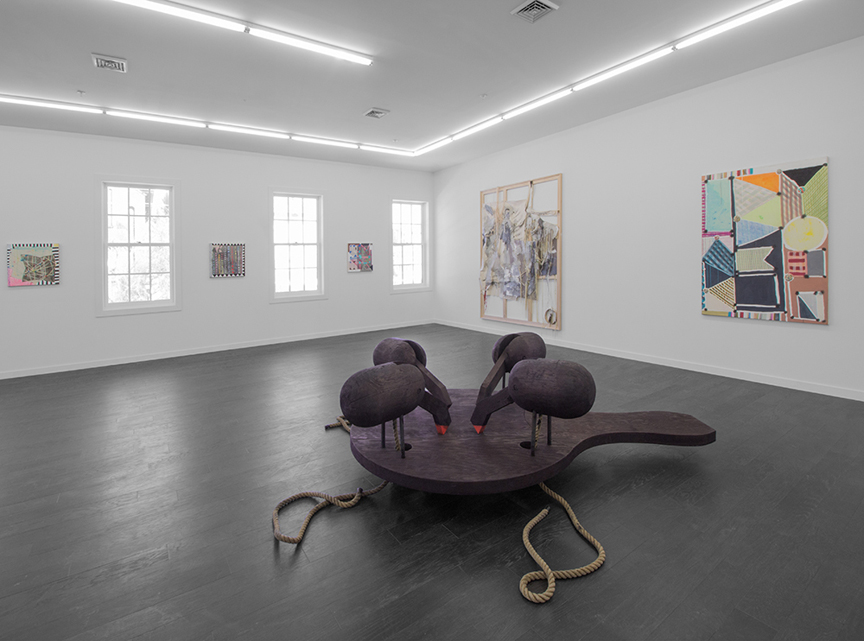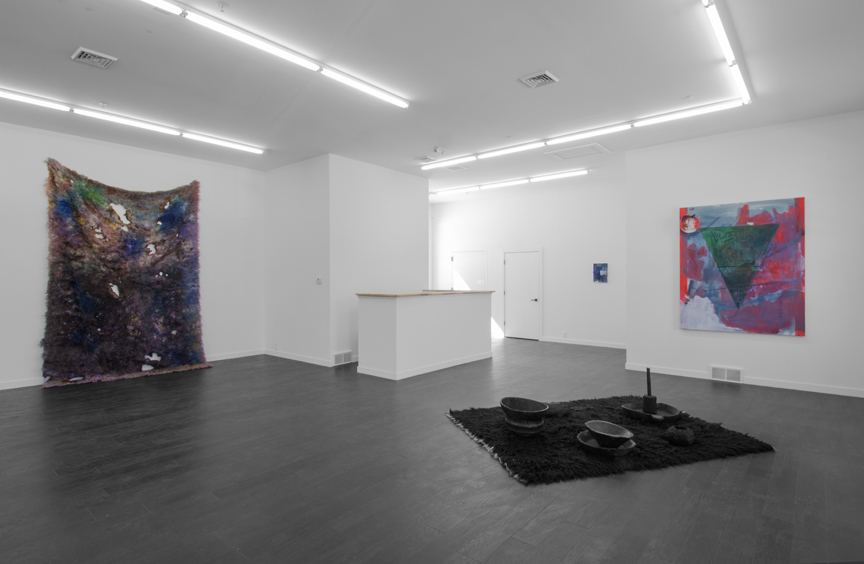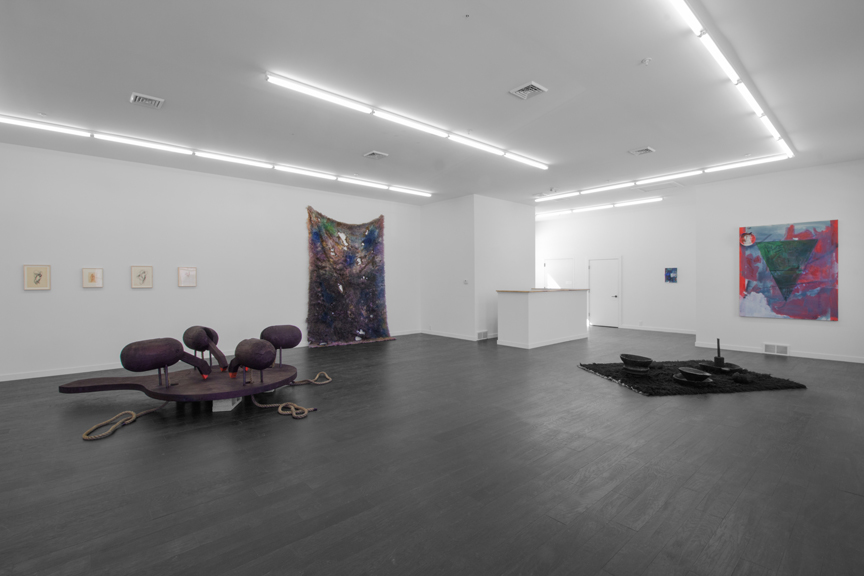Witches
Witches
March 18, 2017-May 07, 2017
Opening Saturday, March 18, 2017, 6–8pm
Anna Betbeze Cameron Rosy Keyser Laurel Sparks Marianne Vitale
Witches, by Susan Aberth:
Witches, an exhibition at SEPTEMBER, presents five artists whose working processes and artwork either directly employs or indirectly suggests magical intentions. The term “witch” has always stood for feminine subversive forces, acting either outside of or in opposition to the oppressive rules of patriarchy. Furthermore, an integral part of witchcraft entails the creation of specially charged objects meant to facilitate magical objectives, such as the rectification of injustices, protection from harm, or the expansion of consciousness. The construction of such objects involves intense focus, repetition, and a certain channeling of outside forces (unconscious and/or supernatural) that directly mirrors art making in general. Surprising to most people is that humor is a powerful tool harnessed into magical service and the artists here deploy it with skill and subtlety. On view from March 18 through May 7, 2017, Witches will present a culminating a series of performances on April 22 in tandem with the theme of the exhibition.
Marjorie Cameron (1922-1995), the great American artist, poet and occultist, serves as the presiding muse of the show with four extraordinary works on paper. Hermit displays one of her signature androgynous figures (often self-portraits) enveloped in a robe constructed of masterful watercolor washes and is reminiscent of the Hermit Tarot card of the major arcana. An untitled pencil drawing reveals the faint silhouette of a woman’s lower torso; while in her womb grows a twisted and strange entity. This haunting and sinister drawing is especially interesting in light of Cameron’s ritual sex magic practices and her desire to create a supernatural “moonchild” in the tradition of Aleister Crowley’s teachings (a pivotal figure in her and her husband Jack Parson’s occult development). Two abstract ink drawings titled Pluto Transiting the Twelfth House represent planetary orbits and their expressively intertwined lines suggest astrological cycles and their consequences. Cameron has been the focus of great art world attention with a series of significant recent exhibitions and it is a great treat to see them here lighting the way with their numinous energy for the other four artists.
Interested in the occult, but not in its organized and more conventional aspects, Anna Betbeze is instead drawn to the harnessing of psychic energies and potentialities. Working with found and second-hand materials such as rugs and furs, the artist adorns her pieces with stains, rips and burnt-out holes. Like decommissioned magic carpets that bear the scars of adventurous travel, they possess a mesmerizingly ruinous beauty. The power of repulsion/attraction is at work here, as well as certain types of artist spellcraft – think of Antonin Artaud’s burnt, folded and bloodstained spells made imprisoned in a mental asylum and meant to kill Nazis. The works have a humorous edge as well, acknowledging how dysfunctional and absurd we can be, especially regarding our bodies and their desires. Talismanic fragments of a deconstructed whole, her works drape and hang with bruised sensitivity, stubbornly maintaining their emotional and social charge. Depending on where and how they are installed, they provoke different types of encounters, but always is the basic and perplexing question – what are these things?
Laurel Sparks openly presents her work as combines of magical materials and ritual practice. Her series of Magic Square constructions take as their inspiration the ancient custom of creating grids where all numbers running across, down and diagonally add up to the same number. But this is just one aspect of
these multifaceted pieces, for Sparks purposefully overlays different kinds of esoteric systems in order to create her own brand of Sigil magic. Sigils refer to occult signs used to summon change based on the practitioners will and in these works she calligraphically inscribes the surface with a variety of hermetic texts that become all the more powerful in their unreadable density. Orchestrating a dizzying array of color, directional markings, and magical intentionalities, the artist strives to open a portal between visible and invisible dimensions. Sparks calls this her own form of an “alchemical wedding,” referring to the mystical conjoining of opposites such as water and fire, night and day, active and passive. Her surfaces mix traditional art materials with magical ones such as salt and selenite, and then go on to incorporate detritus from her life like dirt, fragments of gifts and a variety of “craft” materials (beads, pipe cleaners, plastic flowers) that also reference a queer aesthetic of artifice. Taken altogether the works have an archetypal resonance and function as “vibrational transmitters,” or in other words they are living entities meant to interfere with and influence their surroundings.
Another artist whose work disrupts traditional readings of the grid is Rosy Keyser. In works like Terrestrial Mime (2105), a wooden framework resembling the stretcher bars of a canvas are used as scaffolding for an assemblage of distressed and painted fabric. Raw and wild, the form possesses anthropomorphic qualities, further suggested through a visceral application of paint. They also instigate a host of Pagan associations, such as abject shelters found in the forest or the messy remnants of strange ritual activities undertaken by groups in seclusion. Keyser’s work can act as a provocation to see what happens when we let go of normative systems of measuring and logic. Vulnerable and broken, they nevertheless exude an uncanny alternate energy operating outside of the seen world. Art, like magic, doesn’t work in isolation - even alone in the woods many other forces are at play. Tellingly the artist holds that, on occasion, we all must avail ourselves of the dark in order to see the light.
Practitioners of witchcraft at times incorporate elements of play into their ritual work, invoking the liminal and fluid atmosphere of childhood. Nursery rhymes, jokes, songs, drums, rattling toys and games, anything that employs repetition can be used to raise energetic fields or induce trance states. Marianne Vitale’s floor sculpture, Very Fine Gander (2017) is like those old-fashioned paddleball toys meant to be played while running or skipping across the yard. Impossibly large and grounded, it still brings a smile, even though the cute birds are now scorched and blackened in an alarming manner. One thinks back to those primal urges often connected to child’s play and children’s toys, urges that result in mysterious dismemberments, melting, and other forms of “innocent” destruction. Just as inanimate objects are brought to life and infused with magic when used in play, when burnt and charred they can function as dark talismans of the Burning Times of the Middle Ages. Vitale’s wall assemblages, constructed from pictures disrespectfully torn from books, shuffle time periods and upend aesthetic expectations. Mappings of the artists’ psychic terrain, they can lead the unsuspecting viewer to treasure or traps, another instance of the dangerous and pleasurable transgressions of play.
At this critical juncture in American politics, the use of supernatural forces to fight the restrictive, repressive and draconian threat of the religious right seems both appropriate and urgently needed.
Susan L. Aberth is Associate Professor of Art History at Bard College. Her specialties are Latin American art, Surrealism and occultism. She has written numerous articles and essays on these topics, including Leonora Carrington: Surrealism, Alchemy and Art (Lund Humphries: 2004).
For more information about the artists and works, please contact kristen@septemebrgallery.com.
March 18, 2017-May 07, 2017
Opening Saturday, March 18, 2017, 6–8pm
Anna Betbeze Cameron Rosy Keyser Laurel Sparks Marianne Vitale
Witches, by Susan Aberth:
Witches, an exhibition at SEPTEMBER, presents five artists whose working processes and artwork either directly employs or indirectly suggests magical intentions. The term “witch” has always stood for feminine subversive forces, acting either outside of or in opposition to the oppressive rules of patriarchy. Furthermore, an integral part of witchcraft entails the creation of specially charged objects meant to facilitate magical objectives, such as the rectification of injustices, protection from harm, or the expansion of consciousness. The construction of such objects involves intense focus, repetition, and a certain channeling of outside forces (unconscious and/or supernatural) that directly mirrors art making in general. Surprising to most people is that humor is a powerful tool harnessed into magical service and the artists here deploy it with skill and subtlety. On view from March 18 through May 7, 2017, Witches will present a culminating a series of performances on April 22 in tandem with the theme of the exhibition.
Marjorie Cameron (1922-1995), the great American artist, poet and occultist, serves as the presiding muse of the show with four extraordinary works on paper. Hermit displays one of her signature androgynous figures (often self-portraits) enveloped in a robe constructed of masterful watercolor washes and is reminiscent of the Hermit Tarot card of the major arcana. An untitled pencil drawing reveals the faint silhouette of a woman’s lower torso; while in her womb grows a twisted and strange entity. This haunting and sinister drawing is especially interesting in light of Cameron’s ritual sex magic practices and her desire to create a supernatural “moonchild” in the tradition of Aleister Crowley’s teachings (a pivotal figure in her and her husband Jack Parson’s occult development). Two abstract ink drawings titled Pluto Transiting the Twelfth House represent planetary orbits and their expressively intertwined lines suggest astrological cycles and their consequences. Cameron has been the focus of great art world attention with a series of significant recent exhibitions and it is a great treat to see them here lighting the way with their numinous energy for the other four artists.
Interested in the occult, but not in its organized and more conventional aspects, Anna Betbeze is instead drawn to the harnessing of psychic energies and potentialities. Working with found and second-hand materials such as rugs and furs, the artist adorns her pieces with stains, rips and burnt-out holes. Like decommissioned magic carpets that bear the scars of adventurous travel, they possess a mesmerizingly ruinous beauty. The power of repulsion/attraction is at work here, as well as certain types of artist spellcraft – think of Antonin Artaud’s burnt, folded and bloodstained spells made imprisoned in a mental asylum and meant to kill Nazis. The works have a humorous edge as well, acknowledging how dysfunctional and absurd we can be, especially regarding our bodies and their desires. Talismanic fragments of a deconstructed whole, her works drape and hang with bruised sensitivity, stubbornly maintaining their emotional and social charge. Depending on where and how they are installed, they provoke different types of encounters, but always is the basic and perplexing question – what are these things?
Laurel Sparks openly presents her work as combines of magical materials and ritual practice. Her series of Magic Square constructions take as their inspiration the ancient custom of creating grids where all numbers running across, down and diagonally add up to the same number. But this is just one aspect of
these multifaceted pieces, for Sparks purposefully overlays different kinds of esoteric systems in order to create her own brand of Sigil magic. Sigils refer to occult signs used to summon change based on the practitioners will and in these works she calligraphically inscribes the surface with a variety of hermetic texts that become all the more powerful in their unreadable density. Orchestrating a dizzying array of color, directional markings, and magical intentionalities, the artist strives to open a portal between visible and invisible dimensions. Sparks calls this her own form of an “alchemical wedding,” referring to the mystical conjoining of opposites such as water and fire, night and day, active and passive. Her surfaces mix traditional art materials with magical ones such as salt and selenite, and then go on to incorporate detritus from her life like dirt, fragments of gifts and a variety of “craft” materials (beads, pipe cleaners, plastic flowers) that also reference a queer aesthetic of artifice. Taken altogether the works have an archetypal resonance and function as “vibrational transmitters,” or in other words they are living entities meant to interfere with and influence their surroundings.
Another artist whose work disrupts traditional readings of the grid is Rosy Keyser. In works like Terrestrial Mime (2105), a wooden framework resembling the stretcher bars of a canvas are used as scaffolding for an assemblage of distressed and painted fabric. Raw and wild, the form possesses anthropomorphic qualities, further suggested through a visceral application of paint. They also instigate a host of Pagan associations, such as abject shelters found in the forest or the messy remnants of strange ritual activities undertaken by groups in seclusion. Keyser’s work can act as a provocation to see what happens when we let go of normative systems of measuring and logic. Vulnerable and broken, they nevertheless exude an uncanny alternate energy operating outside of the seen world. Art, like magic, doesn’t work in isolation - even alone in the woods many other forces are at play. Tellingly the artist holds that, on occasion, we all must avail ourselves of the dark in order to see the light.
Practitioners of witchcraft at times incorporate elements of play into their ritual work, invoking the liminal and fluid atmosphere of childhood. Nursery rhymes, jokes, songs, drums, rattling toys and games, anything that employs repetition can be used to raise energetic fields or induce trance states. Marianne Vitale’s floor sculpture, Very Fine Gander (2017) is like those old-fashioned paddleball toys meant to be played while running or skipping across the yard. Impossibly large and grounded, it still brings a smile, even though the cute birds are now scorched and blackened in an alarming manner. One thinks back to those primal urges often connected to child’s play and children’s toys, urges that result in mysterious dismemberments, melting, and other forms of “innocent” destruction. Just as inanimate objects are brought to life and infused with magic when used in play, when burnt and charred they can function as dark talismans of the Burning Times of the Middle Ages. Vitale’s wall assemblages, constructed from pictures disrespectfully torn from books, shuffle time periods and upend aesthetic expectations. Mappings of the artists’ psychic terrain, they can lead the unsuspecting viewer to treasure or traps, another instance of the dangerous and pleasurable transgressions of play.
At this critical juncture in American politics, the use of supernatural forces to fight the restrictive, repressive and draconian threat of the religious right seems both appropriate and urgently needed.
Susan L. Aberth is Associate Professor of Art History at Bard College. Her specialties are Latin American art, Surrealism and occultism. She has written numerous articles and essays on these topics, including Leonora Carrington: Surrealism, Alchemy and Art (Lund Humphries: 2004).
For more information about the artists and works, please contact kristen@septemebrgallery.com.
Witches
March 18, 2017-May 07, 2017
March 18, 2017-May 07, 2017
Read More
 1
1
 2
2
 3
3
 4
4
 5
5
SEPTEMBER




